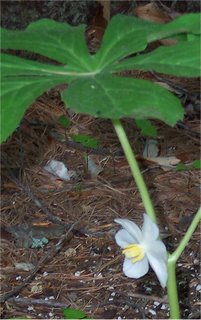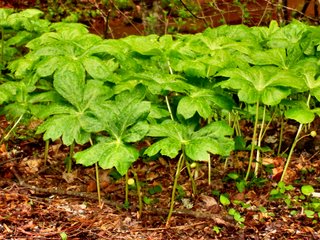The Parasols of May Appear in April

Image: D L Ennis, A cluster of May Apples
If you live anywhere in the eastern half of the United States between Quebec and Florida chances are you have seen May Apples (or Mayapples) growing in the forest. The May apple, Podophyllum peltatum, is one of the simplest to identify of all forest plants.
"About 14 hundred May Apple stems,With their parasols up, marched down the hill.And all the Spring Beautiesturned up their pale, peaked nosesAnd said, "Don't them May Apples Think they're somebodyWith their bumbershoots up!"Oh, it was a grand day, a specially grand day."
-- from "Beautiful Sunday"by Jake Falstaff, Ohio
May Apples appear before the deciduous trees, they grow beneath, leaf out. The plant is sometimes called the umbrella plant because it resembles a closed umbrella when first emerging, then opening into the open umbrella shape. First year plants have only one leaf and will not bloom, while second year plants have two stems and develop a white blossom at the junction of the two stems. The white flower is about 2 inches in diameter, and grows beneath the leaves, and the berry that develops is the "apple" of the plant.
The best places to look for May apple plants are moist, open woods and the edges of boggy meadows. Be on the lookout for a cluster of greenery, rather than lone specimens. The May Apple grows from a single underground rhizoid stem which, in very early spring, sends up dozens of, closed umbrella, shoots sporting young leaves tightly furled around a central stalk. Within a matter of just a few weeks, huge rambling colonies of full-blown specimens twelve to eighteen inches tall blanket entire patches of ground.

Image right: D L Ennis, the flower of the May Apple
The nodding white flower, sometimes two inches across, has six to nine petals and twice as many yellow stamens. The root leaves and stem are poisonous but the ripe fruit, or apple (it is really a berry).
Other names for the May Apple include Devil's Apple, Hog-apple, Indian Apple, American Mandrake, American May Apple, Racoonberry, Wild Lemon.
Once called the witches umbrella and thought to be employed by them as a poison, which may not be untrue! The English version of this plant has much lore told of it, being called Manroot (mandrake) believed to be alive and its screams when pulled from the ground would render a man permanently insane.
American Mandrake, or May Apple, is medicinal and edible (fruit), used extensively by Native Americans. The fully ripe fruit is eaten raw, cooked or made into jams, jellies, marmalades, and pies. It is very aromatic, and has a sweet peculiar but agreeable flavor.
The seeds and rind are not edible, said to be poisonous. The root and plant contain valuable constituents Quercetin, Kaempferol, Podophyllin, Isorhamnetin, Gallic-acid, Berberine, Alpha-peltatin, that are being studied for their healing, anticancer and other properties. The root is used as a medicinal herb, it is antibilious, cathartic, cytostatic, hydrogogue and purgative, it should only be used by professional Herbalists.

Image left: D L Ennis, here you can see the fruit of the May Apple
It is a most powerful and useful alternative medicine. A possible treatment for cancer is being tested as it contains podophyllin, which has an antimiotic effect (it interferes with cell division and can thus prevent the growth of cells). The resin, which is obtained from the root, is used in the treatment of warts.
Warning: The whole plant, apart from the ripe fruit, is highly poisonous in large doses. American Mandrake herb produces nausea and vomiting, and even inflammation of the stomach and intestines, which has been known to prove fatal. In moderate doses, it is a drastic purgative with some cholagogue action. Not a medicinal herb to be used during pregnancy, may cause birth defects.
Technorati Tags: [Blue Ridge Mountains][United States][Quebec][Florida][May Appear][Wildflowers]












1 Comments:
At Sunday, 23 April, 2006, Leslie Shelor said…
Leslie Shelor said…
A group of Mayapple plants is one of my favorite sights in the spring. Thanks for adding so much to my knowledge of this interesting plant!
Post a Comment
<< Home